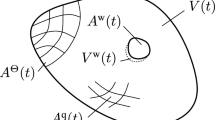Abstract
A problem with the planning solutions for the additive manufacturing material extrusion process is a lack of optimization strategies to improve upon the standard raster and contour tool paths. Bead deposition tool paths can cause unwanted voids, which in turn creates a set of potential failure points within the finished product. This paper aims to identify, minimize, and manage void regions during the tool path generation. The goal is to minimize voids in each layer and to prevent stacked void regions, i.e., avoid creating an internal chimney. Material extrusion processes, with a wide selection of nozzle sizes (0.4 to 21 mm), are considered suitable candidates for this solution. The mathematical model is established based on the component geometry and the available build options for a given machine-material configuration. A C++ program has been developed to select a set of standard (available) tool path parameters to determine the optimal output process variables (bead width, raster angle, and the overlap percentage). Case studies are presented to show the merits of this approach.
Similar content being viewed by others
References
W. Associates (2014) Wohlers report-3D printing and additive manufacturing state of the industry. Annual Worldwide Progress Report. 276 p. https://books.google.ca/books/about/Wohlers_Report_2014.html?id=iCamoAEACAAJ&redir_esc=y
Zhonga G, Vaezi M, Liu P, Lin P, Yang S (2017) Characterization approach on the extrusion process of bioceramics for the 3D printing of bone tissue engineering scaffolds. Ceram Int J 43:13860–13868
Cohen DL (2014) Fostering mainstream adoption of industrial 3D printing: understanding the benefits and promoting organizational readiness. 3D Print Addit Manuf 1.2:62–69
W. Associates (2017) Wohlers report-3D printing and additive manufacturing state of the industry. Publishin Wohlers Associates.
Petrovic V, Gonzalez JVH, Ferrando OJ, Gordillo JD, Puchades JRB, Griñan LP (2011) Additive layered manufacturing: sectors of industrial application shown through case studies. Int J Prod Res 49(4):1061–1079
Rayegani F, Onwubolu GC (2014) Fused deposition modelling (FDM) process parameter prediction and optimization using group method for data handling (GMDH) and differential evolution (DE). Int J Adv Manuf Technol 73(1):509–519
Keles Ö, Blevins CW, Bowman KJ (2017) Effect of build orientation on the mechanical reliability of 3D printed ABS. Rapid Prototyp J 23(2):320–328
Urbanic RJ, DiCecco L (2015) Develpment of adaptable light weighting methods for material extrusion processes. ASME Int Mech Eng Congress Exposition 24:1–10 ISBN: 978-0-7918-5735-9
Gibson I, Rosen DW, Stucker B (2010) Additive manufacturing technologies. Springer, New York. https://doi.org/10.1007/978-1-4419-1120-9
Turner BN, Gold SA (2015) A review of melt extrusion additive manufacturing processes: II. Materials, dimensional accuracy, and surface roughness. Rapid Prototyp J 21(3):250–261
Pandey PM, Reddy MV, Dhande SG (2003) Real time adaptive slicing for fused deposition modelling. Int J Mach Tool Manu 43(1):61–71
Ledalla SRK, Tirupathi B, Sriram V (2016) Performance evaluation of various STL file mesh refining algorithms applied for FDM-RP process. J Inst Eng. https://doi.org/10.1007/s40032-016-0303-4
Carneiro OS, Silva AF, Gomes R (2015) Fused deposition modeling with polypropylene. Mat Des J 83:768–776
Jin GQ, Li W, Tsai CF, Wang L (2011) Adaptive tool-path generation of rapid prototyping for complex product models. J Manuf Syst 30(3):154–164
Jin Y-a, He Y, Xue G-h, Fu J-z (2015) A parallel-based path generation method for fused deposition modeling. Adv Manuf Technol 77:927–937
Debananda M, Sundararajan V, Wright PK (2005) Zig-Zag tool path generation for sculptured surface finishing. DIMACS Ser Discrete Math Theoret Comput Sci 67:265–280
Ahn S-H, Montero M, Odell D, Roundy S, Wright PK (2002) Anisotropic material properties of fused deposition modeling ABS. Rapid Prototyp J 8(4):248–257
Onwubolu GC, Rayegani F (2014) Characterization and optimization of mechanical properties of ABS parts manufactured by the fused deposition modelling process Hindawi Publishing Corporation. Int J Manuf Eng 2014:1–13
Sood AK, Chaturvedi V, Datta S, Mahapatra SS (2011) Optimization of process parameters in fused deposition modeling using weighted principal component analysis. J Adv Manuf Syst 10(2):241–259
Vijayaraghavan V, Garg A, Lam JSL, Panda B, Mahapatra SS (2015) Process characterisation of 3D-printed FDM components using improved evolutionary computational approach. Int J Adv Manuf Technol 78(5–8):781–793
Boschetto A, Bottini L (2014) Accuracy prediction in fused deposition modeling. Int J Adv Manuf Technol 73(5–8):913–928
Masood SH, Rattanawong W, Iovenitti P (2000) Part build orientations based on volumetric error in fused deposition modelling. Int J Adv Manuf Technol 16(3):162–168
Ahn D, Kweon JH, Kwon S, Song J, Lee S (2009) Representation of surface roughness in fused deposition modeling. J Mater Process Technol 209(15–16):5593–5600
Stratasys (2016) FDM 3D Printers. pp 1–9. http://www.stratasys.com/fdm-systems
Acknowledgments
The authors would like to thank Mr. Robert Hedrick of CAMufacturing Solutions Inc. for assistance with the slicing stl files with C++ and Dr. Richard Caron (Professor of Mathematics and Statistics, University of Windsor) for his comments on the mathematical model that greatly improved the manuscript.
Funding
This research is funded by the Natural Sciences and Engineering Research Council of Canada through the Discovery Grant.
Author information
Authors and Affiliations
Corresponding author
Rights and permissions
About this article
Cite this article
Eiliat, H., Urbanic, J. Visualizing, analyzing, and managing voids in the material extrusion process. Int J Adv Manuf Technol 96, 4095–4109 (2018). https://doi.org/10.1007/s00170-018-1820-5
Received:
Accepted:
Published:
Issue Date:
DOI: https://doi.org/10.1007/s00170-018-1820-5




